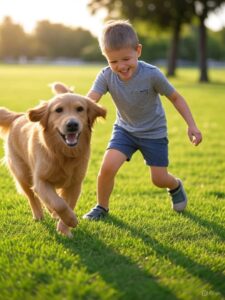🐾 Kids and Dogs: Teaching Respectful, Safe Interactions
Helping Children Build Positive Bonds with Their Canine Companions
Dogs and children can be the best of friends—but only when both understand how to interact respectfully and safely. Many bites and behavioral issues happen not because a dog is “mean,” but because they felt scared, overwhelmed, or misunderstood—especially by young children who simply don’t know any better.
As adults, it’s our job to set dogs and kids up for success. Whether you’ve just adopted a new dog or want to reinforce good habits with the family dog you’ve had for years, this guide will help you teach your children how to interact with dogs safely and kindly.
🧠 Rule #1: Let the Dog Make the First Move
Children should never run up to a dog or force an interaction. Even the friendliest dog needs time to assess and feel comfortable.
Teach your child to:
-
Sit calmly and quietly with their hands in their lap.
-
Avoid loud voices, sudden movements, or reaching out.
-
Let the dog choose to approach when they’re ready.
Dogs feel safest when they’re allowed to initiate contact. When kids wait patiently, they’re showing respect for the dog’s space and feelings.
🤗 Affection ≠ Hugging
Kids naturally want to hug dogs and get close to their faces—it’s how humans express love. But dogs often interpret these behaviors very differently.
Many dogs feel:
-
Trapped when hugged
-
Threatened when someone gets face-to-face
-
Startled when touched suddenly from behind or above
Instead, teach children to:
-
Gently pet the dog’s back or side (not the face or tail)
-
Keep their face away from the dog’s face
-
Watch the dog’s body language: wagging tail = maybe, but a turned head, tucked tail, or stiff posture = stop
Encourage them to show love in dog-friendly ways, like:
-
Tossing a toy
-
Offering a treat (with permission)
-
Speaking kindly or drawing the dog a picture 🐶🎨
🟢 Safe & Respectful Behaviors
Here’s a list of appropriate ways kids can interact with dogs:
-
Sitting near the dog calmly
-
Tossing a toy (if the dog enjoys it)
-
Giving a treat with an open palm
-
Talking softly
-
Petting gently on the back or chest
-
Helping with feeding (under supervision)
And here’s what to avoid:
-
Hugging, kissing, or lying on the dog
-
Climbing on, sitting on, or pulling on the dog
-
Yelling, chasing, or running up to the dog
-
Taking toys or bones from the dog’s mouth
-
Waking a sleeping dog
-
Putting hands near the dog’s food or bowl
🍽️ Mealtime = Alone Time
Dogs should be allowed to eat in peace. Even a gentle dog may react if startled or interrupted while eating.
Teach your children:
-
Don’t touch the food bowl during meals
-
Don’t try to pet, talk to, or play with the dog while they eat
-
Wait until the dog walks away from the bowl before approaching
Setting this boundary prevents accidental bites and helps your dog feel secure in your home.
👁️ Read the Dog’s Body Language
Even young children can learn to recognize signs that a dog feels uncomfortable.
Teach kids to “be a dog detective” and look for:
-
Tail tucked = nervous
-
Ears back = unsure
-
Whale eyes (you see the whites of the eyes) = uncomfortable
-
Lip licking or yawning (when not tired) = stressed
-
Growling = “Please back off!”
Tell children that these are warning signs, not “bad dog” behavior. The dog is asking for space—and we should always listen.
🛑 Always Supervise Interactions
No matter how well your child and dog get along, never leave them alone together unattended, especially if:
-
The dog is new to the home
-
The child is under 10
-
The dog has shown fear or sensitivity to touch
Even the best dog can react if startled or mishandled. Supervision is the key to keeping everyone safe and happy.
💬 Final Thoughts
Dogs aren’t stuffed animals—they’re living, feeling creatures with their own boundaries, preferences, and emotions. By teaching children how to approach dogs with kindness and respect, we’re not just preventing accidents—we’re nurturing empathy, compassion, and lifelong bonds.
A well-taught child is a dog’s best friend. And with your guidance, both can grow up safe, confident, and loved.

